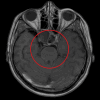Giant Prolactin-Secreting Pituitary Adenoma: A Case Report and Literature Review
- PMID: 40599499
- PMCID: PMC12208814
- DOI: 10.7759/cureus.85126
Giant Prolactin-Secreting Pituitary Adenoma: A Case Report and Literature Review
Abstract
Prolactinomas are the most common functional pituitary adenomas in the pediatric population, though they remain rare overall. Male adolescents often present with larger and more aggressive tumors than female adolescents, with delayed symptoms such as visual disturbances, headaches, and hypogonadism due to the absence of early hormonal signs. We report the case of a 15-year-old previously healthy male patient who presented with a one-month history of severe frontal headache, followed by blurred vision and vomiting. On examination, he exhibited bilateral mydriatic pupils unresponsive to light, left eye outward deviation, ataxic gait, and asthenic appearance. Brain MRI revealed a large sellar mass suggestive of an invasive pituitary adenoma. Laboratory evaluation showed extreme hyperprolactinemia (50,260.9 ng/mL) and central hypothyroidism, leading to the diagnosis of a giant invasive prolactinoma. He was treated with cabergoline and levothyroxine. Due to neuropsychiatric symptoms (hallucinations, insomnia, and agitation), aripiprazole and melatonin were added. No evidence of apoplexy or intracranial hypertension was found. Craniotomy surgery was performed successfully. Clinical improvement was observed, but the patient was lost to follow-up. This case illustrates the classical presentation of giant prolactinoma in a male adolescent, emphasizing the size-prolactin correlation and the importance of early detection and medical treatment. Neuropsychiatric symptoms can emerge as a result of tumor mass effect or dopaminergic therapy. Long-term follow-up is essential to evaluate treatment response and prevent endocrine and developmental complications. Genetic testing for MEN1 or AIP mutations should be considered in young patients with aggressive pituitary adenomas.
Keywords: cabergoline resistance; craniotomy; dopamine agonists; hyperprolactinemia; men1 mutation; pituitary neoplasms; prolactinoma.
Copyright © 2025, Ocon Rodríguez et al.
Conflict of interest statement
Human subjects: Consent for treatment and open access publication was obtained or waived by all participants in this study. Conflicts of interest: In compliance with the ICMJE uniform disclosure form, all authors declare the following: Payment/services info: All authors have declared that no financial support was received from any organization for the submitted work. Financial relationships: All authors have declared that they have no financial relationships at present or within the previous three years with any organizations that might have an interest in the submitted work. Other relationships: All authors have declared that there are no other relationships or activities that could appear to have influenced the submitted work.
Figures


Similar articles
-
Giant prolactinomas, a detailed analysis of 196 adult cases.Pituitary. 2023 Oct;26(5):529-537. doi: 10.1007/s11102-023-01337-0. Epub 2023 Aug 7. Pituitary. 2023. PMID: 37544978
-
Drugs for preventing postoperative nausea and vomiting in adults after general anaesthesia: a network meta-analysis.Cochrane Database Syst Rev. 2020 Oct 19;10(10):CD012859. doi: 10.1002/14651858.CD012859.pub2. Cochrane Database Syst Rev. 2020. PMID: 33075160 Free PMC article.
-
Signs and symptoms to determine if a patient presenting in primary care or hospital outpatient settings has COVID-19.Cochrane Database Syst Rev. 2022 May 20;5(5):CD013665. doi: 10.1002/14651858.CD013665.pub3. Cochrane Database Syst Rev. 2022. PMID: 35593186 Free PMC article.
-
Dopamine agonists for preventing future miscarriage in women with idiopathic hyperprolactinemia and recurrent miscarriage history.Cochrane Database Syst Rev. 2016 Jul 25;7(7):CD008883. doi: 10.1002/14651858.CD008883.pub2. Cochrane Database Syst Rev. 2016. PMID: 27455388 Free PMC article.
-
What Are the Recurrence Rates, Complications, and Functional Outcomes After Multiportal Arthroscopic Synovectomy for Patients With Knee Diffuse-type Tenosynovial Giant-cell Tumors?Clin Orthop Relat Res. 2024 Jul 1;482(7):1218-1229. doi: 10.1097/CORR.0000000000002934. Epub 2023 Dec 28. Clin Orthop Relat Res. 2024. PMID: 38153106 Free PMC article.
References
-
- Pediatric pituitary adenomas. Webb C, Prayson RA. Arch Pathol Lab Med. 2008;132:77–80. - PubMed
-
- Clinical profile and long term follow up of children and adolescents with prolactinomas. Acharya SV, Gopal RA, Bandgar TR, Joshi SR, Menon PS, Shah NS. Pituitary. 2009;12:186–189. - PubMed
-
- Hyperprolactinemia in children and adolescents and longterm follow-up results of prolactinoma cases: a single-centre experience. Kontbay T, Şıklar Z, Özsu E, Uyanık R, Bilici E, Ceran A, Berberoğlu M. Turk J Pediatr. 2022;64:892–899. - PubMed
Publication types
LinkOut - more resources
Full Text Sources
Miscellaneous
